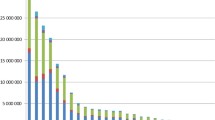Abstract
Introduction:
Influenza continues to be a considerable health problem in Europe. Vaccination is the only preventive measure, reducing mortality and morbidity of influenza in all age groups
Objectives:
The objective of this survey was to assess and compare the level of influenza vaccination coverage during three consecutive influenza seasons (02/03, 03/04, 04/05) in the five European countries United Kingdom, France, Italy, Germany and Spain, understand the driving forces and barriers to vaccination now and 3 years ago and determine vaccination intentions for the following winter.
Methods:
We conducted a random-sampling, telephone-based household survey among non-institutionalized individuals representative of the population aged 14 and over. The surveys used the same questionnaire for all three seasons. The data were subsequently pooled. Four target groups were determined for analysis: (1) persons aged 65 and over; (2) people working in the medical field; (3) persons suffering from chronic illness and (4) a group composed of persons aged 65 and over or working in the medical field or suffering from a chronic illness.
Results:
The overall sample consisted of 28,021 people. The influenza vaccination coverage rate increased from 21.0% in season 02/03 to 23.6% in season 03/04 and then to 23.7% in season 04/05. The differences between the seasons are statistically significant (p = 0.01). The highest rate over all countries and seasons had Germany in season 04/05 with 26.5%, Spain had in season 02/03 with 19.3% the lowest rate totally. The coverage rate in the target group composed of person's aged 65 and over or working in the medical field or suffering from a chronic illness was 49.7% in season 02–04 and 50.0% in season 04/05. The driving forces and barriers to vaccination did not change over the years. The most frequent reasons for being vaccinated given by vaccines were: influenza, considered to be a serious illness which people wanted to avoid, having received advise from the family doctor or nurse to be vaccinated and not wanting to infect family and friends. Reasons for not being vaccinated mentioned by people who have never been vaccinated were: not expecting to catch influenza, not having considered vaccination before and not having received a recommendation from the family doctor to be vaccinated. Options encouraging influenza vaccination are: recommendation by the family doctor or nurse, more available information on the vaccine regarding efficacy and tolerance and more information available about the disease. The adjusted odds ratio of receiving influenza vaccine varied between 2.5 in Germany and 6.3 in the United Kingdom in any risk group.
Conclusion:
The vaccination coverage rate increased from the first season (21.0%) to the third season (23.7%) by 2.6%. The family doctor is the most important source of encouragement for people to be vaccinated against influenza. It seems that the public would be more likely to be vaccinated if they had more information on the efficacy and tolerance of the vaccine, as well as the disease. We therefore suggest that family doctors be better informed on influenza vaccine and the disease itself, so that they can actively inform their patients on these topics.
Similar content being viewed by others
Author information
Authors and Affiliations
Corresponding author
Rights and permissions
About this article
Cite this article
Müller, D., Szucs, T.D. Influenza Vaccination Coverage Rates in 5 European Countries: a Population-Based Cross-Sectional Analysis of the Seasons 02/03, 03/04 and 04/05. Infection 35, 308–319 (2007). https://doi.org/10.1007/s15010-007-6218-5
Received:
Accepted:
Published:
Issue Date:
DOI: https://doi.org/10.1007/s15010-007-6218-5




